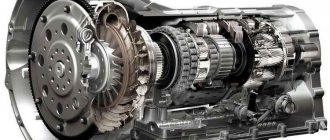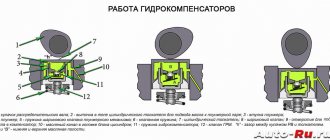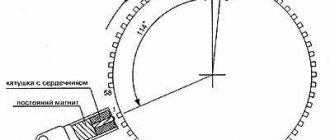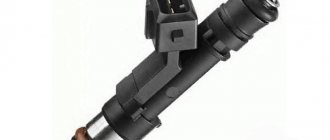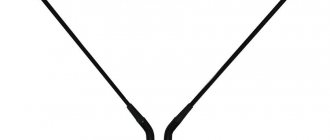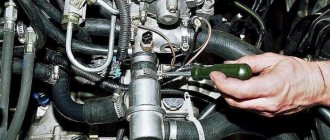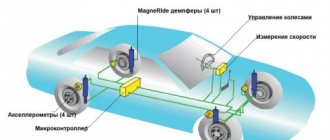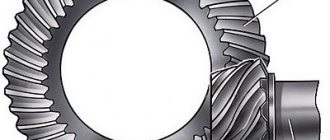Functions and classification of clutch.
The clutch system
is one of the most important systems of a car. Its invention is attributed to Karl Benz. The clutch assembly transmits torque from the engine crankshaft to the gearbox. Its presence allows you to change gears, move away smoothly, and coast. If the clutch fails, it will be impossible to operate the car. In addition to the main function - transmitting torque - the clutch system dampens (dampers) torsional vibrations and inertial moment that inevitably arises during operation of an internal combustion engine, and reduces noise when shifting gears. These are secondary, but also significant functions.
Next we will look at the clutch device
and its most important part - the driven disk. It is this that represents the most structurally and technologically complex element of the system and provides direct transmission of torque. All other parts of the clutch, as will become clear later, provide a control function - the ability to turn the clutch on and off in a car.
The figure on the left shows the most common clutch system - a single-disc dry clutch with a mechanical release drive. It is most common in passenger cars and is used, for example, in the design of the VAZ-2110 model. This clutch consists of: a clutch basket (a pressure plate with a casing and springs), one driven disk with friction linings and a drive disk
, which is the engine flywheel.
The control mechanism, in this case, is a release bearing
with a sleeve and fork driven by a cable.
In addition to this type, there are quite a few different clutch mechanisms, such as multi-plate, cam, powder electromagnetic, and so on. In addition, there are a number of technological solutions for transmitting engine torque to the transmission without using a classic clutch mechanism. The simplest example is a variator.
Details of how clutch systems are classified are shown in the table in the figure below.
We will not dwell in detail on the principles of operation of the clutch mechanism and types of clutch. These issues are well covered in this publication: https://goo.gl/7U1kpX. The operation of the clutch and the principles of its design are clearly demonstrated in the following videos:
clutch discs under the BelAK brand
only
for trucks
.
Trucks usually use a two-disc
or even
a three-disc clutch
. This is due to heavy loads on the unit, high torque and engine power. A double-disc clutch, although more complex and more expensive than a single-disc clutch, is justified in the case of heavy vehicles: the service life is significantly longer and the service interval is longer than that of a single-disc clutch. Let's take a closer look at the double-disc clutch design:
As can be seen from the figures above, these types of clutch differ in the number of driven discs (indicated by arrows). In a two-disc one there are two of them, and in a three-disc one there are three. Hence the name of these systems. Number of pressure plates
also different, and corresponds to the number of slave disks. There are no fundamental differences between multi-disk systems and single-disk systems. The number and area of friction elements simply increases. This increases the reliability of the unit and resistance to loads.
On heavy trucks, a hydraulic clutch is used with additional reinforcement due to pneumatics. To do this, another unit is added to the system - a pneumohydraulic clutch drive booster (PGU). We talked about it in the article: “Pneumo-hydraulic clutch control drive amplifiers are a high-tech product with high market potential.”
BelAK clutch discs
Currently, six types of clutch discs are produced under the BelAK brand. They are manufactured on modern automated production lines. To fasten the friction linings, we use corrosion-resistant brass rivets. The splined hub and damper housing are made of alloy steel. The presence of an idle speed damper and the use of friction linings with an original composition ensures smooth clutch engagement, reliability, and durability.
Clutch driven disc device
The clutch driven disc
is a structurally complex part. It is he who bears the main task of transmitting torque between the engine flywheel and the input shaft of the gearbox. It is largely responsible for the function of damping inertial and torsional vibrations and protects the transmission from damage by such vibrations. .
Operating principle of the driven clutch disc
Each of the friction linings 1 and 13 is riveted separately to four spring plates 3, riveted to the steel disk 5. The plates 3, made of thin sheet steel and slightly curved, play the role of an elastic element for soft engagement of the clutch.
Disk 5 is connected with six springs 11 to hub 8, which sits on the splines of the gearbox input shaft. A flange is made integral with the hub 8, on both sides of which there are disks 5 and 12. These disks are connected to each other by pins 7 riveted on both sides, located in the slots of the flange of the hub 8. Torque from the engine to the input shaft of the box is transmitted at the initial moment through springs 11, the amount of compression of which is proportional to the amount of torque. This ensures smooth clutch engagement. The compression of the springs is limited by the thrust of the fingers 7 into the wall of the cutouts in the hub flange 8. To prevent the occurrence of significant torsional vibrations in the transmission system, a damping device is used, consisting of friction paronite washers 6 and 9, clamped between the hub flange and disks 5 and 12. The damping of vibrations is carried out by friction between these parts. When assembling the clutch at the factory, the friction moment of the vibration damper is set in the range of 1.5-1.9 kgm using steel adjusting washers 10.
Clutch basket
The clutch basket is usually understood as a pressure plate with a casing, pressure springs and elements for fastening the pressure plate to the flywheel. The purpose of the basket is to enable the clutch to be engaged and disengaged. A release bearing is used for this. When you press the clutch pedal, the release bearing moves relative to its free position and presses on the outer ends of the clutch pressure springs. In this case, the spring pressure is removed from the pressure disk, it is pressed away from the driven disk, the driven disk moves along the input shaft of the gearbox and moves away from the engine flywheel. The clutch is disengaged. When the clutch pedal is released, the release bearing returns to its original position, the pressure springs are released, and the pressure disk again puts pressure on the driven disk and presses it against the flywheel. The clutch is engaged.
Service
Maintenance of this mechanism is carried out as follows:
- Carry out an external inspection of the pedal and, if necessary, adjust its free play.
- Bleed the hydraulic drive.
- Carry out diagnostics of the crankcase fastening elements and, if necessary, tighten the nuts.
- Carry out an external inspection of the tension spring device, lubricate the bearings and hydraulic coupling.
- Check the functionality of the clutch switch and the shaft sleeve.
- Inspect the fork and clutch pedal for wear and damage.
- Check the operation of the mechanism by changing the gears of the vehicle on the spot and during acceleration.
- Eliminate incorrectly set gaps between support rings and washers.
- Eliminate leaks in the system and lubricate all cylindrical elements with a special liquid.
- Check the gap between the rods and the piston part of the main cylindrical device.
How to make adjustments
Actions when adjusting the MAZ clutch:
- Adjust pedal free play. To do this, you need to put your foot on the pedal and squeeze the gas all the way. If necessary, reduce or increase the stroke of this device.
- Release the pedal and measure the distance to the lower mark of the coupling mechanism.
- The maximum stroke amplitude should not exceed 16 cm.
- Tighten all fasteners.
- Measure the pedal free play.
After the driver has adjusted the clutch mechanism, it is necessary to adjust the MAZ clutch basket:
- Place the transport on a special platform.
- Unscrew the mounting bolts that connect the gearbox and the car body.
- Remove the gearbox.
- Unscrew the screws of the push-type disk and remove it.
- Inspect the basket and replace damaged or worn parts.
- Adjust the position of the paws.
- Using the adjustment handle, set the paws to the positions shown in the MAZ repair manual.
- Tighten all mounting screws until they are secure.
- Reassemble the mechanism by repeating all steps in reverse order.
How to bleed the clutch on a MAZ
Bleeding the clutch is necessary when gears shift poorly or air gets into the hydraulic system.
Before starting the procedure, it is recommended to fill the hydraulic drive tank with working fluid to the 1-1.5 cm mark. Remove all dirt from the exhaust cylinder valves, remove the protective casing, remove the cap from the top of the master cylinder and put a special hose on it for bleeding.
Gradually it is necessary to lower the free end of the hose into the working fluid poured into the hydraulic drive, lightly pressing the pedal of the coupling mechanism. There should be an interval of 1-2 seconds between presses. A total of 4 pressures are required.
When pressed for the first time, the pedal must be immersed in liquid, at which time it is necessary to unscrew the valve half a turn. During 2, 3 and 4, all system mechanisms are pumped. When the bubbles disappear, you need to stop pressing the pedal. If during the procedure the level of working fluid decreases by 2/3, it is necessary to replenish the missing volume.
Clutch faults
The main causes of clutch malfunctions are improper operation of the vehicle and installation of parts of inadequate quality (defective or counterfeit).
Breakdowns can also occur as a result of natural wear and tear of parts during intensive and prolonged use of the car. But it should be noted that the service life of a high-quality and properly operated clutch is quite high. External signs of clutch failure may include:
- incomplete disengagement (the clutch “drives”);
- incomplete engagement (clutch “slips”);
- jerking when the clutch operates;
- vibration when engaging the clutch;
- noise when disengaging the clutch.
There may be several reasons for this behavior of the system. Here are the main ones:
- wear and damage to the driven disk linings;
- deformation of the driven disk;
- oiling of the driven disk linings;
- wear of the splines of the driven disk;
- wear or breakage of damper springs;
- broken or weakened diaphragm spring;
- wear or breakage of the clutch release bearing;
- flywheel surface wear;
- wear of the pressure plate surface;
- jamming of the clutch release fork.
In any case, if any of the above signs of a clutch malfunction appear, you must contact a service workshop as soon as possible to diagnose and repair the problem. At the same time, very often you will have to buy a clutch disc
to replace a failed one.
You can do this on our website, or by calling our sales department. We sell high-quality cargo clutch discs wholesale and retail. The price of a clutch disc
in our online store is very affordable.
Remember!
Timely repair and diagnostics of the clutch system is the key to a safe and comfortable ride. "BelAvtoKomplekt" - We do not invent specifications. We comply with GOST.
How to make a clutch mechanism with your own hands?
The clutch on a walk-behind tractor works on the principle that provides for increased friction of the components, so rapid wear cannot be avoided. In this case, you should try to make the mechanism yourself. The design of a homemade clutch will be composed of:
- input shaft of the gearbox and flywheel of the Moskvich car;
- hub and steering knuckle from Tavria;
- B-profile;
- Double groove driven pulley;
- Crankshaft from GAZ-69.
Subsequent work on assembling the mechanism looks like this:
- First, you will need to grind the crankshaft so that it does not interfere with other elements of the walk-behind tractor;
- We place the standard walk-behind tractor hub on the shaft;
- Next, you need to machine a place on the shaft for the bearing. This operation should be performed as accurately as possible so that the bearing fits perfectly on the shaft. As a result, the hub should fit without any gaps, and the pulley should rotate;
- Then turn the crankshaft over and do the same on the other side;
- Next, use a drill with a 5mm drill bit to make 6 holes in the pulley. The distance between them should be the same. Since 10mm bolts will be used, holes will also need to be drilled on the back of the wheel that drives the drive belt;
- Next, install the pulley on the flywheel and tighten both parts with a bolt. After this, mark the drill spots on the flywheel so that they coincide with the 6 holes in the pulley;
- Remove the pulley and drill holes in the flywheel;
- After this, put the pulley back on and securely tighten the structure with bolts;
- Grind the inner surface of the crankshaft and flywheel so that they do not hit each other.
The finished structure can be installed in a regular place in the walk-behind tractor. Do not forget to connect the cables, leading them as far as possible from the friction elements.
If the design of your walk-behind tractor does not have a clutch, then you can make a clutch frame for the walk-behind tractor with your own hands. This system must transmit torque from the engine crankshaft to the gearbox.
The process is based on the effect of the clutch on the walk-behind tractor. In this case, the motor and gearbox are disconnected. Due to this system, the cultivator begins to move smoothly and stops without turning off the motor.
What tasks does the clutch for a walk-behind tractor perform?
The clutch for a walk-behind tractor performs the following functions:
- transmits torque;
- dampens rotational vibrations;
- shifts gears smoothly;
- connects gears;
- connects and disconnects the connection between the engine and the gearbox;
- disconnects the transmission from the flywheel.
Depending on the design of the cultivator, there are different types of clutch.
The centrifugal system uses a clutch cable on a walk-behind tractor, a flywheel, a shaft, a handle, a disk, and a washer. Under heavy loads the system slips, so it is not widely used.
The hydraulic clutch of the walk-behind tractor transmits movement to the piston when pressing on the pedal through a connecting rod, which directs the working fluid through the channel using a squeezing method. The piston acts on the lever through the connecting rod, the handle returns back using a spring.
An automatic clutch on a walk-behind tractor is installed on motor cultivators with high engine power. Single-disc and multi-disc systems ensure smooth switching on of the unit and the start of its movement.
Pneumatic booster
Some cars that have increased loads during operation have a pneumatic booster. For example, such an amplifier is installed on KAMAZ vehicles. This amplifier is designed to reduce the main force that the driver applies to the clutch pedal.
It is also worth noting that there are different types of gearboxes - mechanical, automatic and robotic. This implies a difference in the clutches used on such cars. So, for example, on manual transmissions, a single, dry clutch is used, and on automatic transmissions, they mainly use a multi-plate wet clutch. Robotic gearboxes use two clutches, and they work alternately.
There are also two clutch release options:
- With electric actuator;
- With hydraulic actuator.
We hope you got an idea of how the clutch works in a car and learned a lot of interesting things about the types of clutch, its structure and amplifier. As can be seen from the article, the operation of the clutch is not complicated, but the clutch mechanism itself is quite complex. Therefore, we should not forget about timely maintenance of the clutch, in particular its adjustment.
Choosing a new clutch basket
Usually the clutch basket is not sold as an independent part, but comes complete with a bearing and discs. This set is called a clutch kit. However, if you are faced with wear on the diaphragm spring, you are unlikely to need all the other parts in the kit. Sometimes the basket is sold separately from all other clutch components. You can search for it by:
- VIN code of the car;
- Basic parameters of the car;
- Code of the required spare part.
Since a car enthusiast usually does not know the code for a suitable cart, it is better to search for it using the car parameters in online stores. For example, on, where a simple and intuitive system for searching for spare parts is implemented, taking into account such vehicle parameters as make and model, engine parameters, year of manufacture. We advise you to pay attention to the manufacturer. The following companies offer the highest quality baskets:
- Valeo (France);
- LuK (Germany);
- Exedy (Japan);
- Sachs (Germany).
The same thing that LuK and Sachs have is offered by the German company INA. Cheaper analogues can be found from Mecarm (Italy) and JP Group (Denmark). We do not recommend saving much on clutch components, however, in the case of a basket, you can still save wisely. A good option would be a clutch from the Japanese ]Exedy[/anchor] or the most affordable analogue under the name of one of the brands of the German Schaeffler, which are listed above.
Features of clutch for mini-equipment
The question of what kind of clutch can be made for a homemade mini tractor so that it lasts as long as possible worries every novice designer.
However, experienced specialists, despite the design innovations that have appeared today, unanimously argue that it is better to give preference to the oldest method - a belt clutch. Although it has a number of disadvantages, taking into account the fact that we are going to adapt it to a small farm unit - a mini-tractor, this variety will be quite sufficient. In addition to this clutch, other more modernized analogues are:
- electromagnetic;
- disk;
- hydraulic principle of operation;
- centrifugal.
The scheme for its manufacture is quite simple, despite serious controversy regarding the overall complexity of this process. It consists of the following:
- Take two V-belts, the length of which should be 1.4 m. It is advisable to select them with profile B;
- a pulley is installed on the input shaft of the gearbox (it will be the “driven” element);
- a double-design roller is installed on a spring-loaded bracket, 8 links of which are connected to the direct clutch pedal. It will provide the necessary tone of the belts, as well as their weakening during the slipping cycle;
- To keep the wear of parts to a minimum, it is better to take care of special stops designed specifically for those moments when the engine is idling.
This design has a number of undeniable advantages:
- work balance;
- reliability of operation;
- low cost, since there is no need to fork out for expensive elements, and everything you need can always be found in your utility room.
To complete this design block, we advise you to stock up on a gearbox in advance, perhaps even a previously used one. It can be adapted from any old car, for example GAZ-51.
Walk-behind tractor controls
This is a system of mechanisms that allows you to change the speed and direction of movement of the walk-behind tractor. The controls include the steering wheel, clutch and gear levers, throttle control knob and much more. Since walk-behind tractors do not have a seat for the operator, this means that maneuvering of such equipment is ensured with the help of hands. But, if you can buy a cart with a seat in a specialized store, you will get a mini-tractor.
The clutch of a walk-behind tractor is an important element of the transmission, through which the engine crankshaft transmits torque to the gearbox mechanisms. Using this part, the engine and gearbox are disconnected when changing gears. It is due to the participation of the clutch that the walk-behind tractor moves smoothly and also stops without completely shutting off the engine.
Classification of diaphragm baskets
Structurally, even simple diaphragm clutch baskets can differ from each other. As practice has shown, a simpler design is more reliable, but its main disadvantage is its greater thickness. According to the principle of operation, baskets are divided into:
- Push;
- Exhaust.
In the case of pressure baskets, interaction with the clutch mechanisms is carried out by moving the petals in the direction of the flywheel. If we are talking about exhaust baskets, then the petals, on the contrary, are displaced from the flywheel. By the way, this particular design can boast of the smallest dimensions - it has less thickness and allows you to save a little space under the hood.
It is customary to place baskets with a powerful diaphragm spring, which has significant downforce, into a separate category. As a rule, the downforce of such diaphragms is 50% greater than that of standard diaphragms. They differ from the latter in more complex geometry and other materials. It is recommended to install special baskets exclusively on tuned cars. They guarantee faster clutch response and better transfer of power from the engine.
Extensive functionality
The grip on the walk-behind tractor is of great importance when driving. Without it, it’s difficult to get going, although it’s possible. If it fails, it is better to immediately begin repairing it. A malfunctioning clutch for a walk-behind tractor in a manual transmission leads to damage to the entire transmission. In this sense, the centrifugal clutch has proven itself better, since it has found application in automatic transmissions. If it fails, the walk-behind tractor will not budge at all, which means it will not cause other damage.
The centrifugal clutch for a light walk-behind tractor includes:
- flywheel;
- hub with locking groove and key;
- pulley;
- flange;
- bearing;
- sleeve;
- retaining ring;
- casing
Making a clutch for a heavy or light walk-behind tractor with your own hands requires certain knowledge and experience. If you have them, then get started right now. For reliable operation of the centrifugal type, it is necessary to reduce the weight of the pads to 110 grams. Initially, each of them weighs 134 grams. It is necessary to remove the rubber rings from under the pads and install rigid springs in their place.
Centrifugal clutch on a walk-behind tractor
Clutch
from an eight drum.
The control mechanism includes push-up levers, which are connected to the pressure plate by a pull and push-out pedal. When disengaging the clutch, the operator sends a pedal or lever with a fork or cable force to the compression levers through a retractable bearing. The outer end is connected to the pressure plate bolts, the levers, when the springs are compressed, drive the actuator from the pressure, thereby releasing the clutch.
The bearing reduces friction by eliminating contact between the fixed bend and the rotating arms. Typically the configuration has three arms at 120 degrees to each other. With the help of a spring, the parts of the control mechanism return to their original position. The discharge is divided by the amount of clearance from the levers required to completely disconnect the coupling. If this distance is not observed, the clutch slips and the friction linings wear out. When the gap exceeds the required distance, the clutch will not disengage completely. to menu
Equipping a mini tractor with a belt clutch
The V-belt drive for a mini tractor is similar in design to the classifications discussed above. It also consists of main and driven components, which in this case are represented by pulleys.
To equip it we need:
- 2 belts, the length of which should not exceed 140 mm. Each of them will take over the function of forward and reverse gears;
- spring rollers that will help tension the belt belts;
- guide plate made of durable metal;
- 2 guide bars, commensurate with the size of the pulleys.
The work progress consists of the following actions:
- a three-strand pulley is installed on the engine crankshaft, which will ultimately become the leading link of our homemade design;
- We also equip the input shaft of the gearbox with a second pulley - this is the basis of the driven clutch mechanism;
- we follow the rule that the pulleys that are closest to the motor must form two strictly parallel planes;
- We equip the spring-loaded bracket with rollers, which will create the effect of tensioning the belts or loosening them if necessary;
- We will equip the reverse belt with a special guide – a metal plate. In this case, the belt itself must be connected to the pulley and roller on its opposite side;
- We install guide strips on the rear pulley and rollers, which should go around the resulting structure from different sides.
The described clutch design for a mini tractor is quite simple to assemble and is resistant to motor vibrations. Promotes stable operation of the mini tractor and is considered the most budget option: there is no need to buy expensive spare parts and shell out for their expensive maintenance.


